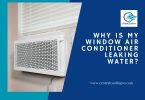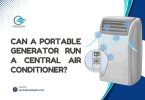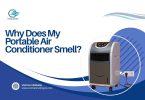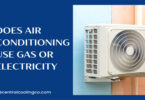Introduction:
Portable air conditioners are a convenient and efficient way to cool a room, but they can sometimes experience issues, such as leaking water. This problem can be frustrating, but understanding the reasons behind it and knowing how to address it can help ensure your portable air conditioner works effectively. In this comprehensive guide, we will explore the factors that can cause a portable air conditioner to leak water and provide detailed information on diagnosing and resolving the issue.
What Is A Portable Air Conditioner?
A portable air conditioner is a compact mobile cooling device that cools a single room or area. Unlike traditional central air conditioning systems, which are permanently installed, portable air conditioners can be moved from room to room, making them a versatile and convenient cooling solution. However, like all appliances, they can experience issues, including water leakage.
Why Do Portable Air Conditioners Leak Water?
Water leakage from a portable air conditioner is primarily due to the process of cooling and dehumidifying the air. As the unit cools the warm air in a room, it removes moisture, which condenses into water. Normally, this water is collected and drained out of the unit. However, several factors can cause this drainage system to malfunction, leading to water leaks.
In the following sections, we will delve into the various causes of water leakage in portable air conditioners and how to diagnose and address each issue.
Causes Of Portable Air Conditioner Water Leaks:
 Understanding the specific causes of water leakage is crucial in addressing the issue effectively. Let’s explore the most common factors that can lead to water leaks in portable air conditioners.
Understanding the specific causes of water leakage is crucial in addressing the issue effectively. Let’s explore the most common factors that can lead to water leaks in portable air conditioners.
Condensate Drain Blockage:
The primary cause of water leakage in portable air conditioners is a blocked or clogged condensate drain. This drain carries the condensate (water) from the unit to a collection pan or external drainage system. If it becomes blocked with dirt, dust, or debris, the water can’t escape, leading to overflow and leaks.
Improper Installation:
Incorrect installation of a portable air conditioner can also result in water leakage. For example, suppose the unit is not level or is tilted in the wrong direction. In that case, water may not flow properly into the condensate drain, causing it to pool inside the unit and eventually leak.
High Humidity:
In environments with high Humidity, portable air conditioners must work harder to remove moisture from the air. This increased moisture load can sometimes overwhelm the unit’s drainage system, causing water to accumulate and leak.
Overcooling:
Setting the air conditioner too low or using it in a space smaller than its recommended capacity can lead to overcooling. Excess condensation can be generated when the cooling process is too aggressive, potentially overwhelming the drainage system and leading to leaks.
Ambient Temperature:
The effectiveness of a portable air conditioner can be affected by the ambient temperature of the room. The unit may not work efficiently in extremely hot or cold conditions, resulting in insufficient moisture removal and possible water leakage.
Unit Tilt Or Level:
As mentioned, the portable air conditioner should be level and tilted to ensure proper water drainage. If not, water may not flow toward the condensate drain as intended, leading to leaks.
Internal Damage:
Internal components of the portable air conditioner, such as the evaporator coil or the condensate pump, can become damaged over time. When these components don’t function as they should, it can result in water leakage.
In the next section, we will discuss how to diagnose the specific cause of water leakage in your portable air conditioner.
Diagnosing The Issue Of Water Leakage In Portable Air Conditioner:
 Diagnosing the cause of water leakage in your portable air conditioner is a critical first step in resolving the problem. Here are some methods to help you identify the source of the issue:
Diagnosing the cause of water leakage in your portable air conditioner is a critical first step in resolving the problem. Here are some methods to help you identify the source of the issue:
Visual Inspection:
Begin by examining the unit and its surroundings. Look for signs of water accumulation, such as puddles or damp spots on the floor or around the unit. Check for any visible blockages in the condensate drain or any damaged components.
Listening For Unusual Sounds:
Sometimes, you can hear gurgling or sloshing sounds from the portable air conditioner, indicating a drainage issue. These sounds are caused by water pooling inside the unit.
Monitoring Water Accumulation:
Place a container or towel under the unit to collect water. By tracking how much water accumulates and where it’s coming from, you can gain insight into the nature of the leak. Is the water coming from the front or back of the unit, or is it pooling inside?
After diagnosing the issue, you can address the problem based on the specific cause you’ve identified. In the following sections, we’ll explore the steps to prevent leaks and the actions you can take to resolve each of the common causes of water leakage.
Steps To Prevent Water Leaks:
Preventing water leaks in your portable air conditioner involves proactively addressing the potential causes we discussed earlier. Here are steps you can take to minimize the risk of leaks:
Regular Maintenance:
Proper maintenance is essential to keep your portable air conditioner functioning smoothly. This includes cleaning or replacing the air filter, which ensures efficient airflow and cooling.
Proper Installation:
When setting up your unit, ensure it is placed on a level surface and tilted slightly backward. This promotes the correct flow of condensate into the drain.
Managing Humidity:
In high-humidity environments, consider using a dehumidifier with your portable air conditioner to reduce the workload on the drainage system.
Adjusting Temperature Settings:
Avoid setting the air conditioner to a temperature lower than necessary. This can reduce the amount of condensate produced and minimize the risk of leaks.
Ensuring Proper Tilt And Level:
Regularly check the unit is level and tilted appropriately for effective water drainage. Adjust the positioning as needed.
Handling Internal Damage:
If you suspect internal components are damaged, consult the manufacturer’s manual or contact a repair technician.
Let’s investigate specific troubleshooting steps for addressing water leaks based on the identified causes.
Troubleshooting And Fixing Leaks:
Depending on the cause of the water leak, you can take various troubleshooting steps to resolve the issue. Here’s how to address each common cause of water leakage:
Cleaning Or Replacing The Air Filter:
If the air filter is dirty or clogged, it can impede airflow and cause the unit to overwork. Clean or replace the filter as the manufacturer’s manual recommends to improve efficiency and reduce the risk of leaks.
Clearing The Condensate Drain:
Clear any blockages in the condensate drain using a pipe cleaner, a small brush, or compressed air. This will ensure that water can flow freely out of the unit.
Addressing Improper Installation:
Ensure the unit is level and tilted backward to promote proper water drainage. Make any necessary adjustments to its position.
Reducing Humidity:
In high-humidity conditions, use a separate dehumidifier to reduce the moisture in the air, which can lessen the load on the air conditioner’s drainage system.
Adjusting Temperature Settings:
Avoid overcooling by setting the air conditioner to a temperature that provides comfort without excessive condensate production.
Correcting Tilt And Level:
Regularly check that the unit is properly positioned and adjust to ensure proper water drainage.
Dealing With Internal Damage:
If you suspect internal damage, consult the manufacturer’s manual for guidance on component replacement or contact a professional repair technician.
When To Seek Professional Help:
While many water leakage issues can be resolved through the troubleshooting steps outlined in this guide, there are instances where professional assistance is necessary. Consider seeking professional help in the following situations:
- The portable air conditioner continues to leak water despite addressing potential causes.
- You suspect significant internal damage or malfunction.
- You are unsure about how to disassemble or repair internal components.
- The unit is under warranty, and you want to avoid voiding the warranty by attempting repairs yourself.
Professional technicians have the expertise and tools to diagnose and repair complex issues, ensuring your portable air conditioner operates efficiently and without leaks.
Conclusion:
To the measures outlined above, it’s essential to emphasize the significance of understanding the specific environmental conditions impacting your portable air conditioner’s performance. Factors such as room size, insulation levels, and even the layout of furniture can influence how effectively the unit operates and how much moisture it removes from the air. Moreover, ensuring adequate ventilation in the room can aid in expelling warm, moist air generated by the cooling process, reducing the likelihood of condensation buildup and subsequent leaks. By considering these additional aspects and incorporating them into your maintenance routine, you can further enhance the efficiency and reliability of your portable air conditioner, prolonging its lifespan and minimizing the occurrence of water leakage incidents.
Regular maintenance, proper installation, and attention to environmental conditions can go a long way in preventing water leaks. Troubleshooting and fixing leaks can often be accomplished by cleaning the air filter, clearing the condensate drain, adjusting temperature settings, and ensuring the unit is level and tilted correctly. However, in cases of internal damage or unresolved issues, it’s advisable to seek professional assistance to ensure the long-term performance of your portable air conditioner.By taking these steps and staying vigilant, you can enjoy the benefits of a cool and comfortable environment while keeping water leakage issues at bay.
Disclosure: We may get commissions for purchases made through links in this post.








